

HOME>HOT SPRINGS
Myoko's onsen, or hot springs are, along with the region's deep snows, its true treasures. The many onsen located around the base of Mt. Myoko are renowned for their charm. After a day of enjoying the Myoko's magnificent natural setting, wind down with a long, relaxing soak in one of the many onsen.
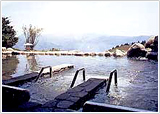
- Akakura Onsen
- Opened in 1816, Akakura Onsen is the largest of Myoko's onsen, and one
long popular with Japanese and international tourists.
Located some 780 meters (2,500 feet) above sea level,
Akakura boasts scenic beauty and magnificent views. The
steam of the onsen and high snow walls make this a perfect place for a relaxing
stroll. The waters of Akakura Onsen have therapeutic properties,
and are highly valued for healing and promoting beautiful
skin.
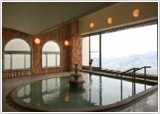
- Shin-Akakura Onsen
- Shin-Akakura Onsen is a tranquil hot spring surrounded by woods. It
was developed as a resort at the fork of the road to Akakura
Onsen and Ikenotaira Onsen. Shin-Akakura Onsen has the
same hot water source as Akakura Onsen, making the baths
good for the skin and healing. Surrounded by groves of
white birches and Japanese larches, Shin-Akakura's serene
environs are perfect for relaxing. Directly below the face
of Mt. Myoko, it is ideal for visitors who want to experience
this elegant, distinctive mountain.
.
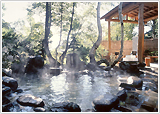
- Ikenotaira Onsen
- Surrounded by white birches, Ikenotaira Onsen is a hot springs resort
on the highlands with beautiful views all season round.
Imori Ike (literally, "Salamander Pond") has long been
a symbol of Ikenotaira. The pond perfectly reflects Mt.
Myoko; in the summer, alpine plants burst into bloom, creating
a landscape of rich beauty .
Soaking in these natural hot spring waters is perfect for
relaxing and recuperating from work fatigue.
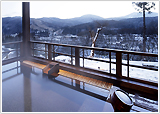
- Myoko Onsen
- Myoko Onsen is in the area's "old town" and easily accessible—just
15 minutes on foot from JR Myokokogen Station.
This hot spring, shared with Ikenotaira Onsen, provides
a soft, gentle stimulation to the skin—perfect for those
who like a long, lingering soak. Myoko Onsen provides a
full view of the majesty of Mt. Myoko and its surroundings.
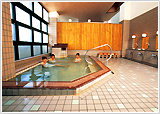
- Suginosawa Onsen
- Suginosawa is an area of natural mountains, fields, and old-growth forests—it is home to the famous Naena Falls, (one of the 100 Famous Waterfalls of Japan) and a gateway to hiking trails. Suginosawa Onsen is ideal for recuperating after a day of skiing, camping, trekking or mountain-climbing. The soothing waters are well known for their warming effect during cool months and are popular for day trips as well.
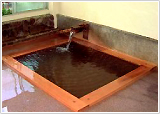
- Seki Onsen
- Open since 1729, Seki Onsen has the longest history of the Myoko hot springs. The traditional streets still retain the atmosphere of days when spa trips for healing were lengthy affairs—a slower pace that visitors continue to find soothing. The water contains iron, and is well known for the lasting effect of heating the body. High in the mountains, Seki Onsen is a popular destination for mountain climbing and nature hikes from spring to fall and skiing in the winter.
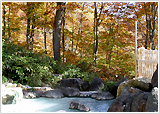
- Tsubame Onsen
- Set on a spectacular cliff-side setting, Tsubame Onsen has long been a destination for those desiring the road less traveled. This hot spring is named for the iwa tsubame, members of the swallow family that nest under eaves and on area cliffs. The atmosphere here is pleasant, reminiscent of ages past. Some facilities close in the winter because of the heavy snows—others offer a unique wintertime experience, with access only by snow cat. The hot spring water is a milky white, and gives the skin a healthy sheen.



